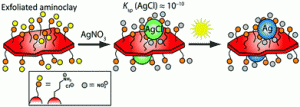A novel environmentally friendly method has been presented for the synthesis of dual metallic silver (Ag) and gold (Au) nanoparticles on aminoclay nanosheets (ACN). Typically, synthesis of metal nanoparticles requires the aid of toxic reducing agents or complex chemical synthesis and purification. Baker and co-workers have proposed a one-pot method that utilizes ACN to stabilize precipitating nanoparticles, thus discovering that photochemical reduction using natural unfocused light to be the most time- and energy-efficient method for producing stable nanodispersions in water.
The dual AgAu materials were investigated as catalysts and anti-microbial agents and interestingly showed better activity than analogues synthesised from gold or silver alone. This article highlights the advantages of green synthesis and the potential of hybrid metallic nanoparticles in two different applications. The authors speculate that this generic method could also be expanded to drug delivery, water purification and biological applications.
Sunlight-assisted route to antimicrobial plasmonic aminoclay catalysts
Sudhir Ravula, Jeremy B. Essner, Wendy A. La, Luis Polo-Parada, Roli Kargupta, Garret J. Hull, Shramik Sengupta and Gary A. Baker
Nanoscale, 2015, 7, 86-91. DOI: 10.1039/C4NR04544K
Dr Mike Barrow is a guest web writer for the Nanoscale blog. He currently works as a Postdoctoral Researcher at the University of Liverpool.











